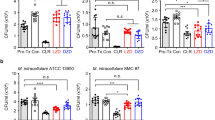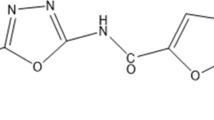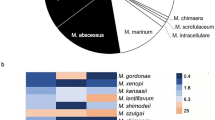Abstract
Antimicrobial resistance is a global health problem. In 2021, it was estimated almost half a million of multidrug-resistant tuberculosis (MDR-TB) cases. Besides, non-tuberculous mycobacteria (NTM) are highly resistant to several drugs and the emergence of fluoroquinolone (FQ) resistant M. tuberculosis (Mtb) is also a global concern making treatments difficult and with variable outcome. The aim of this study was to evaluate the activity of the FQ, DC-159a, against Mtb and NTM and to explore the cross-resistance with the currently used FQs.
A total of 12 pre-extensively drug-resistant (XDR) Mtb, 2 XDR, 36 fully drug susceptible strains and 41 NTM isolates were included to estimate the in vitro activity of DC-159a, moxifloxacin (MOX) and levofloxacin (LX), using minimal inhibitory and bactericidal concentration (MIC and MBC). The activity inside the human macrophages and pulmonary epithelial cells were also determined.
DC-159a was active in vitro and ex vivo against mycobacteria. Besides, it was more active than MOX/LX. Moreover, no cross-resistance was evidenced between DC-159a and LX/MOX as DC-159a could inhibit Mtb and MAC strains that were already resistant to LX/MOX.
DC-159a could be a possible candidate in new therapeutic regimens for MDR/ XDR-TB and mycobacterioses cases.
This is a preview of subscription content, access via your institution
Access options
Subscribe to this journal
Receive 12 print issues and online access
$259.00 per year
only $21.58 per issue
Buy this article
- Purchase on Springer Link
- Instant access to full article PDF
Prices may be subject to local taxes which are calculated during checkout


Similar content being viewed by others
References
Murray CJL, et al. Global burden of bacterial antimicrobial resistance in 2019: a systematic analysis. Lancet 2022;399:629–55.
WHO. WHO Global Tuberculosis Report. 2020. https://www.who.int/publications/i/item/9789240013131.
CDC. Emergence of Mycobacterium tuberculosis with extensive resistance to second-line drugs worldwide. MMWR Morb Mortal Wkly Rep. 2006;55:301–5.
WHO. WHO Extensively drug-resistant tuberculosis (XDR.TB): recommendations for prevention and control. Wkly Epidemiol Rec. 2006;81:430–2.
Nahid P, et al. Treatment of drug-resistant tuberculosis. an official ATS/CDC/ERS/IDSA clinical practice guideline. Am J Respir Crit Care Med. 2020;201:500–1.
Imperiale BR, Di Giulio AB, Cataldi AA, Morcillo NS. Evaluation of Mycobacterium tuberculosis cross-resistance to isoniazid, rifampicin and levofloxacin with their respective structural analogs. J Antibiot. 2014;67:749–54.
Cheng AF, et al. Multiplex PCR amplimer conformation analysis for rapid detection of gyrA mutations in fluoroquinolone-resistant Mycobacterium tuberculosis clinical isolates. Antimicrob Agents Chemother. 2004;48:596–601.
Ruiz J. Mechanisms of resistance to quinolones: target alterations, decreased accumulation and DNA gyrase protection. J Antimicrob Chemother. 2003;51:1109–17.
Hooper DC, Wolfson JS. Fluoroquinolone antimicrobial agents. N. Engl J Med. 1991;324:384–94.
Falkinham JO 3rd. Nontuberculous mycobacteria in the environment. Clin Chest Med. 2002;23:529–51.
Simons S, et al. Nontuberculous mycobacteria in respiratory tract infections. Eastern Asia. Emerg Infect Dis. 2011;17:343–9.
Prevots DR, Marras TK. Epidemiology of human pulmonary infection with non-tuberculous mycobacteria: a review. Clin Chest Med. 2015;36:13–34.
Henkle E, Hedberg K, Schafer SD, Winthrop KL. Surveillance of extrapulmonary nontuberculous mycobacteria infections, Oregon, USA, 2007–2012. Emerg Infect Dis. 2017;23:1627–30.
Brode SK, Marchaund-Austin A, Jamieson FB, Marras TK. Pulmonary versus nonpulmonary nontuberculous Mycobacteria, Ontario, Canada. Emerg Infect Dis. 2017;23:1898–901.
Cassidy PM, Hedberg K, Saulson A, McNelly E, Winthrop KL. Nontuberculous mycobacterial disease prevalence and risk factors: a changing epidemiology. Clin Infect Dis. 2009;49:e124–e9.
To K, Cao R, Yegiazaryan A, Owens J, Venketaraman V. General overview of nontuberculous mycobacteria opportunistic pathogens: Mycobacterium avium and Mycobacterium abscessus. J Clin Med. 2020;9:254.
Hoefsloot W, et al. The geographic diversity of nontuberculous mycobacteria isolated from pulmonary samples: an NTM-NET collaborative study. Eur Respir J. 2013;42:1604–13.
Karakousis PC, Moore RD, Chaisson RE. Mycobacterium avium complex in patients with HIV infection in the era of highly active antiretroviral therapy. Lancet Infect Dis. 2004;9:557–965.
Imperiale B, et al. Disease caused by non-tuberculous mycobacteria: diagnostic procedures and treatment evaluation in the North of Buenos Aires Province. Rev Argent Microbiol. 2012;44:3–9.
Falkingham JO. Epidemiology of infection by nontuberculous mycobacteria. Clin Microbiol Rev. 1996;9:177–215.
Imperiale BR, et al. Genetic diversity of Mycobacterium avium complex strains isolated in Argentina by MIRU-VNTR. Epidemiol Infect. 2017;145:1382–91.
El-Zaatari FA, Osato MS, Graham DY. Etiology of Crohn’s disease: the role of Mycobacterium avium paratuberculosis. Trends Mol Med. 2001;7:247–52.
Thorel MF, Krichevsky M, Lévy-Frébault VV. Numerical taxonomy of mycobactin-dependent mycobacteria, emended description of Mycobacterium avium, and description of Mycobacterium avium subsp avium subsp nov, Mycobacterium avium subsp paratuberculosis subsp nov, and Mycobacterium avium subsp silvaticum subsp nov. Int J Syst Bacteriol. 1990;40:254–60.
Alvarez J, et al. Genetic diversity of Mycobacterium avium isolates recovered from clinical samples and from the environment: molecular characterization for diagnostic purposes. J Clin Microbiol. 2008;46:1246–51.
Martin A, Colmant A, Verroken A, Rodriguez-Villalobos H. Laboratory diagnosis of nontuberculous mycobacteria in a Belgium Hospital. Int J Mycobacteriol. 2019;8:157–61.
Prevots DR, Loddenkemper R, Sotgiu G, Migliori GB. Non tuberculous mycobacterial pulmonary disease: an increasing burden with substantial costs. Eur Respir J. 2017;49:1700374.
Piersimoni C, Scarparo C. Pulmonary infections associated with non-tuberculous mycobacteria in immunocompetent patients. Lancet Infect Dis. 2008;8:323–34.
García García JM, Gutiérrez Palacios JJ, Sánchez Antuña AA. Respiratory infections caused by environmental mycobacteria. Arch Bronconeumol. 2005;4:206–19.
Hoshino K, et al. In vitro and in vivo antibacterial activities of DC-159a, a new fluoroquinolone. Antimicrob Agents Chemother. 2008;52:65–76.
Disratthakit A, Doi N. In vitro activities of DC-159a, a novel fluoroquinolone, against Mycobacterium species. Antimicrob Agents Chemother. 2010;54:2684–6.
Yamaguchi T, Yokoyama K, Nakajima C, Suzuki Y. DC-159a shows inhibitory activity against DNA gyrases of Mycobacterium leprae. PLoS Negl Trop Dis. 2016;10:e0005013. 28
Koide K, et al. Antibacterial activity of DC-159a against Salmonella Typhimurium. Micro Drug Resist. 2019;25:14–22.
Cynamon M, Sklaney MR, Shoene C. Gatifloxacin in combination with rifampicin in a murine tuberculosis model. J Antimicrob Chemother. 2007;60:429–32.
Nuermberger EL, et al. Moxifloxacin-containing regimen greatly reduces time to culture conversion in murine tuberculosis. Am J Respir Crit Care Med. 2003;169:421–6.
Drlica K, Zhao X, Kreiswirth B. Minimising moxifloxacin resistance with tuberculosis. Lancet Infect Dis. 2008;8:273–5.
Martin A, et al. Multicenter study of MTT and resazurin assays for testing susceptibility to first-line anti-tuberculosis drugs. Int J Tuberc Lung Dis. 2005;9:901–6.
Bals R, Hiemstra PS. Innate immunity in the lung: how epithelial cells fight against respiratory pathogens. Eur Respir J. 2004;23:327–33.
Schleimer RP, et al. Epithelium, inflammation, and immunity in the upper airways of humans: studies in chronic rhinosinusitis. Proc Am Thorac Soc. 2009;6:288–94.
Strieter RM, Belperio JA, Keane MP. Host innate defenses in the lung: the role of cytokines. Curr Opin Infect Dis. 2003;16:193–8.
Kamerbeek J, et al. Simultaneous detection and strain differentiation of Mycobacterium tuberculosis for diagnosis and epidemiology. J Clin Microbiol. 1997;35:907–14.
Imperiale BR, Zumárraga MJ, Di Giulio AB, Cataldi AA, Morcillo NS. Molecular and phenotypic characterisation of Mycobacterium tuberculosis resistant to anti-tuberculosis drugs. Int J Tuberc Lung Dis. 2013;17:1088–93.
Moyano RD, et al. Genetic diversity of Mycobacterium avium sp. paratuberculosis by mycobacterial interspersed repetitive Unit-Variable number tandem repeat and multi-locus short-sequence repeat. Int J Mycobacteriol. 2021;10:51–9.
Morcillo NS, et al. A microplate indicator-based method for determining the susceptibility of multidrug-resistant M. tuberculosis to antimicrobial agents. Int J Tuberc Lung Dis. 2004;8:253–9.
Andrews JM. Determination of minimum inhibitory concentrations. J Antimicrob Chemother. 2001;48:5–16.
Morcillo N, Imperiale B, Di Giulio B. Evaluation of MGIT 960™ and the colorimetric-based method for tuberculosis drug susceptibility testing. Int J Tuberc Lung Dis. 2010;14:1169–75.
Mor N, Heifets L. MICs and MBCs of clarithromycin against Mycobacterium avium within human macrophages. Antimicrob Agents Chemother. 1993;37:111–4.
Mosmann T. Rapid colorimetric assay for cellular growth and survival: application to proliferation and cytotoxicity assays. J Immunol Methods. 1983;65:55–63.
Kim HY. Statistical notes for clinical researchers: Chi-squared test and Fisher’s exact test. Restor Dent Endod. 2017;42:152–5.
Sekiguchi J, Disratthakit A, Maeda S, Doi N. Characteristic resistance mechanism of Mycobacterium tuberculosis to DC-159a, a new respiratory quinolone. Antimicrob Agents Chemother. 2011;55:3958–60.
Pitaksajjakul P, et al. Mutations in the gyrA and gyrB genes of fluoroquinolone-resistant Mycobacterium tuberculosis from TB patients in Thailand. Southeast Asian J Trop Med Public Health. 2005;36:228–37.
Nakamura H, Horita Y. Comparative Evaluation of New Respiratory Quinolone DC-159a or Moxifloxacin Containing Regimens in a Murine TB Model. [Abstract 038] ASM Microbiome. 2017: session 035. REF: https://www.newtbdrugs.org/pipeline/compound/dc-159a.
Paillard D, Grellet J, Dubois V, Saux MC, Quentin C. Discrepancy between uptake and intracellular activity of moxifloxacin in a Staphylococcus aureus-human THP-1 monocytic cell model. Antimicrob Agents Chemother. 2002;46:288–93.
Ahmad Z, et al. Activity of the fluoroquinolone DC-159a in the initial and continuation phases of treatment of murine tuberculosis. Antimicrob Agents Chemother. 2011;55:1781–3.
Tandon R, Nath M. Tackling drug-resistant tuberculosis: current trends and approaches. Mini Rev Med Chem. 2017;17:549–70. 2017
Soni I, De Groote M, Dasgupta A, Chopra S. Challenges facing the drug discovery pipeline for non-tuberculous mycobacteria. J Med Microbiol. 2016;65:1–8.
Kumar D, Negi B, Rawat DS. The anti-tuberculosis agents under development and the challenges ahead. Future Med Chem. 2015;7:1981–2003.
Acknowledgements
DC-159a was provided by Daiichi Sankyo Co., Ltd. (Tokyo, Japan). This work was financially supported by National Agency of Scientific and Technological Promotion (PICT 2020-1134).
Author information
Authors and Affiliations
Corresponding author
Ethics declarations
Conflict of interest
The authors declare no competing interests.
Additional information
Publisher’s note Springer Nature remains neutral with regard to jurisdictional claims in published maps and institutional affiliations.
Supplementary information
Rights and permissions
Springer Nature or its licensor (e.g. a society or other partner) holds exclusive rights to this article under a publishing agreement with the author(s) or other rightsholder(s); author self-archiving of the accepted manuscript version of this article is solely governed by the terms of such publishing agreement and applicable law.
About this article
Cite this article
Imperiale, B.R., Mancino, M.B., Moyano, R.D. et al. In vitro and ex vivo activity of the fluoroquinolone DC-159a against mycobacteria. J Antibiot 77, 306–314 (2024). https://doi.org/10.1038/s41429-024-00709-3
Received:
Revised:
Accepted:
Published:
Issue Date:
DOI: https://doi.org/10.1038/s41429-024-00709-3



